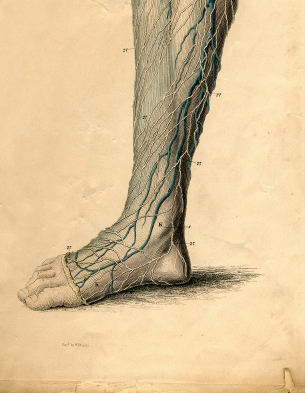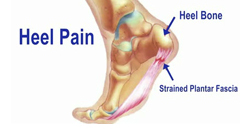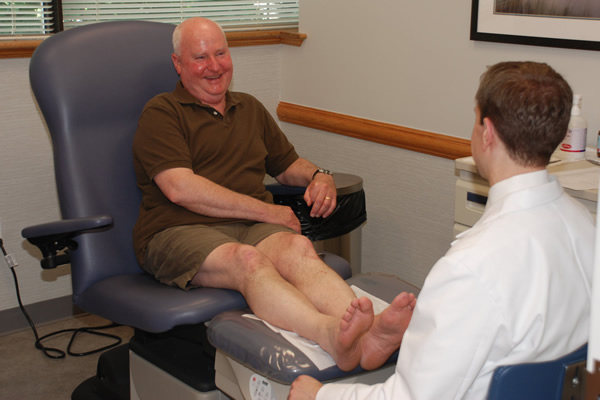Featured
Nerve Disorders of the Foot and Ankle
 Similar to well known nerve disorders in the hands, such as carpal tunnel syndrome, nerve disorders that affect the foot and ankle occur in patients for reasons ranging from stress to genetics. Nerve disorders of the foot should be addressed right away because they may be immobilizing in serious cases. Two of the most common nerve disorders of the foot and ankle are Interdigital Neuroma and Tarsal Tunnel Syndrome.
Similar to well known nerve disorders in the hands, such as carpal tunnel syndrome, nerve disorders that affect the foot and ankle occur in patients for reasons ranging from stress to genetics. Nerve disorders of the foot should be addressed right away because they may be immobilizing in serious cases. Two of the most common nerve disorders of the foot and ankle are Interdigital Neuroma and Tarsal Tunnel Syndrome.
Interdigital Neuroma is caused by localized inflammation of one of the nerves that controls toe sensitivity in the frontal area of the foot. This inflammation is generally only found in the second or third interspace, and any other symptoms similar to Neuroma on other digits should be checked against other disorders. Symptoms include chronic burning or tingling sensations between the affected toes which can, at times, migrate to the toes themselves. This pain is often increased by walking, running, or by wearing shoes that compress the toes, such as high heels. A doctor should be consulted if this pain is chronic and if the symptoms get worse.
Typical examinations to determine the presence of Neuroma include radiographs, MRIs, and even bone scans of the affected area. Bone scans are only required if degeneration of bone is suspected, however. Surgery is often not required to alleviate the symptoms of Neuroma, and in many cases functional orthotics can be used to alleviate the stress of constant weight on the affected toes. Surgery is recommended for those patients that suffer from symptoms for 6 months or more, so reporting symptoms early can increase the rate of non-surgical recovery.
Tarsal Tunnel Syndrome, a condition that is less common than Interdigital Neuroma, is similar to Carpal Tunnel Syndrome in that it is caused by a compression of the nerve caused by any number of factors (mostly associated with excess pronation). Typically seen in those that have either flatfeet or valgus heel positions, Tarsal Tunnel Syndrome has patients complaining of moderate to severe ankle pain that starts along the bottom of the foot and often proceeds to the calf. Some more extreme cases occur with partial numbness and even atrophy of the foot and surrounding muscles.
If there is a good chance that someone has Tarsal Tunnel Syndrome, an EMG test is often used to diagnose the condition. If the diagnosis is positive, an MRI can be used to identify the compression of the nerve. Treatment with NSAIDS, functional orthotics, and rest off of the feet is often prescribed, but again, long standing symptoms require surgery, as do exacerbated symptoms caused by lesions present between nerves.
Heel Pain
 Heel pain is a stressful condition that affects day to day activities. Running and walking causes stress on the heel because the heel is the part of the foot that hits the ground first. This means that the heel is taking on your entire weight. Diagnosis and treatments for heel pain can be easily found through your podiatrist.
Heel pain is a stressful condition that affects day to day activities. Running and walking causes stress on the heel because the heel is the part of the foot that hits the ground first. This means that the heel is taking on your entire weight. Diagnosis and treatments for heel pain can be easily found through your podiatrist.
One of the main causes of heel pain is a condition known as plantar fasciitis. The plantar fascia is a band of tissue that extends along the bottom of the foot, from the toe to the bottom of the heel. A rip or tear in this ligament can cause inflammation of these tissues, resulting in heel pain. People who do not wear proper fitting shoes are often at risk of developing problems such as plantar fasciitis. Unnecessary stress from ill fitting shoes, weight change, excessive running, and wearing non-supportive shoes on hard surfaces are all causes of plantar fasciitis.
Achilles tendonitis is another cause of heel pain. Similar to plantar fasciitis, inflammation of the Achilles tendon will cause heel pain due to stress fractures and muscle tearing. A lack of flexibility of the ankle and heel is an indicator of Achilles tendonitis. If left untreated, this condition can lead to plantar fasciitis and cause even more pain on your heel.
A third cause of heel pain is a heel spur. A heel spur occurs when the tissues of the plantar fascia undergo a great deal of stress, leading to a separation of the ligament from the heel bone entirely. This results in a pointed fragment of bone on the ball of the foot, known as a heel spur.
Treatments for heel pain are easy and effective as long as problems are addressed quickly. The most common solution is simply taking stress off the feet, particularly off of the heel. This will ease the pain and allow the tendons and ligaments to relax. In the case of both plantar fasciitis and Achilles tendonitis, icing will reduce swelling of any part of the foot and anti-inflammatory medication is highly recommended. Properly fitting your shoes and wearing heel pads or comfort insoles will also reduce the risk of developing heel pain. Stretching before and after exercises such as running will help the foot muscles prepare for stress and lower the chances of inflammatory pain. In extreme cases, relieving heel pain might require surgery. Always make sure to discuss these symptoms and treatment options with your podiatrist to keep yourself active and pain free.
Keywords: Heel pain, Achilles Tendonitis, Plantar Fasciitis, Heel Spur, Heel Pain Treatment, Stress on the Foot, Foot Tissue Tear, Foot Inflammation
What Is A Podiatrist?
The branch of medicine that is focused on the treatment, diagnosis, and study of disorders of the lower leg, ankle and foot is referred to as podiatry. Because people often spend a great deal of their time on their feet, many problems in this area can occur. A person seeks help from the field of podiatry when they need treatment for heel spurs, bunions, arch problems, deformities, ingrown toenails, corns, foot and ankle problems, infections, and problems with the foot that are related to diabetes and additional diseases.
To treat problems of the foot, ankle or lower leg, a podiatrist may prescribe physical therapy, drugs, perform surgery, or set fractures. Individuals may also be recommended to wear corrective shoe inserts, custom-made shoes, plaster casts and strappings in order to correct deformities.
When trying to gather information on a patient problem, a scanner or force plate may be used in order to design orthotics. During this procedure, patients are told to walk across a plate that is connected to a computer; the computer then takes a scan of the foot and indicates weight distribution and pressure points. The computer readouts will give the podiatrist information to help them determine the correct treatment plans.
Diagnosis is also provided through laboratory tests and x-rays. Through the foot, the first signs of serious problems such as heart disease, diabetes and arthritis can show up. For example, individuals that have diabetes may frequently have problems such as infections and foot ulcers because they experience poor circulation in the foot area. A podiatrist can then have consultations with patients when symptoms arise and referrals will be made to specialists that handle the greater health problems.
Some podiatrists have their own solo small private practices or clinics where they have a small staff and administrative personnel but many work within group practices. They usually spend time performing surgery in ambulatory surgical centers or hospitals or visiting patients in nursing homes. They typically spend between 30 to 60 hours of week working. Some podiatrists specialize in public health, orthopedics, surgery, or primary care. Some other fields include specialties in geriatrics, dermatology, pediatrics, diabetic foot care and sports medicine.
Some podiatrist specialists complete extra training in the area of foot and ankle reconstruction that result from the effects of physical trauma or diabetes.
How To Choose a Podiatrist
Injuries of the foot can be very difficult problems to diagnose. Most general practitioners are only equipped to deal with relatively easy types of foot injury. If it is any more serious than a mild sprain to the ankle, then it is a better idea to seek the assistance of a podiatrist. These doctors specialize in the treatment of the foot, and therefore are better able to give you an accurate diagnosis when dealing with such issues.
In order to go and see a podiatrist, you will usually have to get a referral through your general practitioner or family doctor. Since they are specialists, sometimes this is the only way that they will take on a new patient. It may also be a requirement of one's insurance agency to do things this way.
Before choosing a podiatrist, it’s a good idea to look into what type of podiatrist you need. There are a few areas of specialization within the field of podiatry. Sports podiatry focuses on sports-related injuries and implementing a plan of action that can get the injured players back into the activities they are into. Bio-mechanical podiatry specializes in knowing precisely which way the foot should move in everyday life. These are the more general doctors that can instruct you in day to day pain. Surgical podiatrists focus on fixing foot issues through surgical means. They are usually a last resort, and you will normally get referred to one from a more general type of foot doctor if necessary. When selecting a podiatrist, it is crucial that you make sure you choose one that best fits the problems that you are having. A sports based doctor is not going to be the best choice if you are suffering from diabetes related foot issues, for instance.
The best way to research a foot doctor in your area is generally with a simple internet search. There are a variety of sites that will give reviews based on customer experiences with different doctors. This can be a great source of information, but it does not always give a full picture of the doctor's performance. Many people only take the time to review something when they have had a negative experience. This can skew the results so keep this in mind during your research. It's also a good idea to request a suggestion from your family doctor. Try to ask them on a personal level, like who they would refer a family member to. If you do it this way, you may get a better recommendation.
Choosing A Podiatrist
A doctor who specializes in treating foot disorders such as warts, bunions, calluses, hammertoes, ingrown toenails, heel pain and corns is called a podiatrist. Most people tend to ignore the feet, which should not be the case as they play just as important a role as other parts of the body.
Choosing a podiatrist should be accorded the same seriousness you would use when choosing any other doctor. Do your homework and make sure you get the kind of podiatrist you need.
Finding a podiatrist shouldn't be difficult. Ask your friends, physician, relatives, the local hospital, insurance companies, surf the Internet, look in the telephone directories and advertisements both on the radio and on newspapers.
Ask around about a podiatrist or do some research online before setting up an appointment. Nurses are good sources of information as they work closely with doctors and understand them. Other avenues you need to consider are the medical boards, as well as referral patients that have been treated by the same doctor. Also, it is a good idea to find out whether the podiatrist you are interested in is involved in and knowledgeable about the latest treatment options and procedures. This is especially important for those with serious foot problems.
So you have found the specialist you like, but are you comfortable enough with him? Your comfort should be given priority, as you will be spending a considerable amount of time with him. The only way to find this out is by booking an appointment with him and observing his attitude toward you, toward other patients, and toward his coworkers. A good podiatrist should be able to put a patient at ease as well as explain problems and procedures. They should be willing to spend as much time as necessary to help a patient understand his or her condition and the options available to them.
The next thing to be considered is cost. Fees should not be exorbitant, but cheap can also be expensive. You may think that you have found the best deal only to make a later discovery that the hospital you settled for is not well equipped and offers substandard treatment. If this is the case, the problem you are being treated for may not be resolved as smoothly as it should. Fees should be reasonable and the receptionist or office manager should be ready to help with any financial concerns you might have.
Videos
About The Podiatry Center, Featuring Dr. Howard Hyman, DPM, FACFAS
Foot and Heel Pain, Featuring Dr. Howard Hyman, DPM, FACFAS
Patient Testimonial - Ingrown Toenail
Custom Orthotics, Featuring Dr. Karyn Goldberg, DPM, FACFAS
Diabetic Foot Care, Featuring Dr. Nathan Jennato, DPM
Ingrown Toenails, Featuring Dr. Nathan Jennato, DPM
Patient Testimonial - Joint Replacement
Enriched Plasma Protein, Featuring Dr. Karyn Goldberg, DPM, FACFAS
Insurance
We accept many various HMOs, PPOs, and other health insurance plans. Call our office today to make sure our office accepts your insurance carrier.
Accepted Health Insurances
We accept the following Health Insurances:
AHP
Amerihealth
Americaid
Americhoice
Anthem Health
Better Health Network
ChoiceCare
Cigna Healthcare (All)
Consumer Health Network
Empire Blu Choice
Empire Blue Cross & Blue Shield
Empire Healthchoice
Empire Medicare
First Health
Footcare Network
GHI
Healthpayors Organization (HPO)
Horizon Blue Cross & Blue Shield
Horizon HMO Blue
Integrated Health Plan
Mercy Health Plan
Magnacare
Medichoice
MHBP
Multiplan
NALC-National Asso.Letter Carriers
One Health Plan
Oxford
United Heathcare
PHCS
Healthnet
Qualcare
St. Barnabas Health System
Wellchoice
Directions
New Patient Forms
Patient Forms
Please print and fill out these forms so we can make your first visit as efficient as possible:
In order to view or print these forms you will need Adobe Acrobat Reader installed.
Application Article
{chronocontact}applicatiion{/chronocontact}
More...
Patient Education
Our podiatric specialists and staff members work together to ensure that the health of our patients is the absolute best it can be. We strive to improve patient health by focusing on preventing, diagnosing, and treating feet ailments and conditions. Please use our podiatric library to learn more about podiatric problems, as well as treatments available. If you have any questions or need to schedule an appointment, please feel free to contact us.
Learn more about Foot Conditions and The Podiatry Center Here
Our Office
Our podiatry practice takes great pride in the comfort, convenience, and expertise we can offer our patients. To ensure your convenience, below is the information you need about our hours, location, appointment scheduling, insurance acceptance and billing.
The Podiatry Center
90 Millburn Ave. , Suite 203
Millburn, NJ 07041
973-762-9294
973-762-9262 fax

Monday | 8:00am - 6:00pm |
Appointments
Are you in need of an appointment? No worries. Requesting an appointment is simple through our website. Simply go to the request an appointment page and fill out your information!
If you need to cancel your appointment, or if you are running late, please call us as soon as possible. Please give us 24 hours notice of appointment cancellation.
Our Office
It's no secret that we believe our patients deserve the very best. We believe in educating every patient on how they can make good choices about their foot and ankle care. We take pride in educating our patients and beginning a relevant treatment program with the best care available. We'll work together with you to find the solution to make sure your feet and ankles are pain free.
It is very important to us that we provide our patients with a wonderful office experience. Our friendly staff works to the best of their abilities to ensure that you have an enjoyable visit. Visit us today! If you have any questions or concerns, please feel free to e-mail or call our office. You can do so using the contact us or request an appointment pages of our website.
Insurance
We accept many various HMOs, PPOs, and other health insurance plans. Call our office today to make sure our office accepts your insurance carrier.
Accepted Health Insurances
We accept the following Health Insurances:
Aetna PPO
AHP
Amerihealth
Americaid
Americhoice
Anthem Health
Better Health Network
ChoiceCare
Cigna Healthcare (All)
Consumer Health Network
Empire Blu Choice
Empire Blue Cross & Blue Shield
Empire Healthchoice
Empire Medicare
First Health
Footcare Network
GHI
Healthpayors Organization (HPO)
Horizon Blue Cross & Blue Shield
Horizon HMO Blue
Integrated Health Plan
Mercy Health Plan
Magnacare
Medichoice
MHBP
Multiplan
NALC-National Asso.Letter Carriers
One Health Plan
Oxford
United Heathcare
PHCS
Healthnet
Qualcare
St. Barnabas Health System
Wellchoice
Our Staff

Our staff is extremely friendly and accommodating. Not only do we take pride in prompt scheduling, but same day appointments are available as well. Additionally, we have a fully computerized and electronic insurance claim submission for premium patient convenience.
New Patients
First impressions have the ability to determine how a relationship will be founded. During your first visit to our practice, we will make you feel at home. Not only will we allow you time to get to know your doctor, but we will also be sure to obtain important background information such as your medical history. The rest of this page will give you a better idea of what to expect for your first visit to our practice.

Here, you will find extremely useful information such as a map and directions to our office, practice hours, payment policies, and more. You will also be able to learn more about the background of our staff members, as well as our first visit procedures. We even have patient forms available for you to print out and complete ahead of time so that you can save time at your appointment.
Mission Statement
Our mission at The Podiatry Center is to provide exceptional podiatric medical care in a state of the art, compassionate, patient centered environment.
To fulfill this mission, we are committed to:
• Listening to those we are privileged to serve.
• Earn the trust and respect of patients, profession and community.
• Exceed your expectations.
• Ensure a creative, challenging and compassionate professional environment.
• Strive for continuous improvement at all levels.
Patient Forms
Please print and fill out these forms so we can make your first visit as efficient as possible:
In order to view or print these forms you will need Adobe Acrobat Reader installed. Click here to download it.
Directions
Click here for directions. Please feel free to e-mail us or call 973-762-9294 with any questions you may have.
What to Expect
Being prepared for your appointment will help us be sure we can provide the best possible care for you. By filling out your paperwork ahead of time, not only will we have all of the necessary information to treat you, but this will also relieve any unnecessary anxiety you may be experiencing. It is a good idea to educate yourself on your symptoms by reviewing the information on our website. Also, feel free to review our staff page and get to know our doctors and staff members. We look forward to seeing you at your first visit!
Services
As a patient, you may have a variety of podiatric needs that need to be taken care of. Whether it be routine checkups or treatments for surgery, our podiatrists are here to handle all of your podiatric needs.
We are able to provide focused treatment and diagnosis for:
• Achilles Tendonitis/Rupture | • Hammertoes |
Foot and Heel Pain, Featuring Dr. Howard Hyman, DPM, FACFAS
We also have a variety of facilities and equipment. These include:
• Foot Surgery at Saint Barnabas Medical Center and The Millburn Surgical Center
• Laser Equipment
• Ultrasound Equipment
• Digital X-ray Equipment
• Protein Enriched Plasma (PRP)
• State of the Art Orthotics Scanning
• Diabetic Foot Care
• Diabetic Shoes
• Extra Corporol Shockwave
• Pediatric Foot Care
• Sports Medicine

